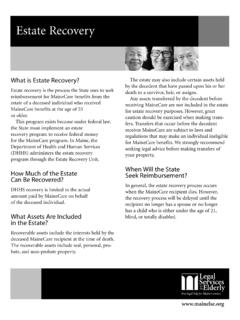Transcription of Magistrate’s Court versus High Court default …
1 Magistrate s Court versus High Court default judgment anomaly must be eliminated By Dennis Sibuyi The basis for setting aside a default judgment in the High Court inexplicably and unaccountably differs from that which is applicable in the Magistrate s Court . It is an anomaly that must surely be eliminated without delay. A default judgment, either in the High Court or in the Magistrate s Court , can be set aside on the basis of the relevant Court rules or common law. The High Court Rules 31 and the Magistrate s Court Rules 49 define the basis for rescission of a default judgment. Once the High Court or the Registrar has granted a default judgment, the judgment debtor may, within 20 days of acquiring the knowledge of the judgment, apply to Court to set aside the judgment. In the High Court , the applicant must show a good cause to the claim in order for the Court to set aside the default judgment. There is an extensive case law that defines a good cause , or a bona fide defence for setting aside a High Court default judgment.
2 In the Magistrate s Court , the party seeking rescission of the judgment must serve and file the application, accompanied by a supporting affidavit, giving reasons for the default , within 20 days of acquiring knowledge of the judgment. In short, it is only when the applicant intends to defend the proceedings that he is required to s ho w a defence to the claim. Interestingly, the Magistrate s Court Rules 49(4) provide for various scenarios upon which a default judgment may be set aside without the need to show a defence to the claim. In this case, the applicant need only satisfy the Court that there was no wilful default and that the judgment was satisfied, or arrangements had been made to satisfy the judgment, within a reasonable time of acquiring knowledge of the judgment. Rule 49(5) provides for an application for rescission of a default judgment where the applicant had secured from the judgment creditor a letter of consent to rescind the judgment.
3 Here the applicant need only attach the letter of consent to the rescission application and does not have to allege or show a defence to the claim. The Magistrate s Court Rules do not require the applicant to set out a defence to the claim if the applicant is in possession of a letter of consent from the judgment creditor. However, in the High Court , whether the applicant wishes to defend the matter or not, or had satisfied the judgment in full and/or arrangements had been made to satisfy the judgment within a reasonable time, or the applicant had filed a letter of consent from the judgment creditor, the applicant is obliged to set out a bona fide defence to the claim, in addition to the reasons for default . In essence, the Magistrate s Court Rules justifications, whereby the applicant may set aside a default judgment are not good enough in the High Court . Here the applicant is expected to set out a bona fide defence to the actual claim and failure to do so will result in the application being dismissed.
4 Several cases highlight the High Court s approach, among them La z ar us v N e dc o r B a nk an d Lazarus v ABSA Bank [1]. In both cases the applicants were husbands and wives against whom Nedbank and ABSA had taken default judgments for an amount of R134 000 and R61 000 respectively. The judgment for R61 000 was granted by the Registrar and the judgment for R134 000 was granted by the Court . The applicants, armed with letters of consent to rescission of the judgments from both banks, applied to Court for reconsideration and rescission of the judgments . The Court dismissed both applications, pointing out that in the High Court a default judgment may be rescinded on the basis of Rule 31 of the Uniform Rules of the Court or common law. [2] The Court said that the applicants must show good cause as required by Rule 31(2)(b) of the Rules of the Court and maintained that in addition to reasons for default , the applicant had to show that he or she had a bona fide defence to the actual claim.
5 The Court added that the requirement for a bona fide defence had become a universal approach adopted by Provincial and Local Divisions of the High Court in South Africa and neighbouring states.[3] It maintained that the same requirements would apply irrespective of whether the default judgment had been granted by the Registrar or the Court . Once it was established that the Court or the Registrar had, at the time, been fully entitled to grant the default judgment on the presented facts, the requirements for setting aside such default judgment remained the same. The counsel for the applicants in Lazarus s case argued that the Court ought to consider the Magistrate s Court Rule 49 and highlighted the anomaly between the treatment of similar applicants in similar situations before the High Court and the Magistrate s Court .[4] In particular, the counsel requested the Court to eliminate the perceived anomaly .
6 The Court conceded that the anomaly existed if rescission of a default judgment was granted in the Magistrate s Court on the strength of a letter of consent from the judgment creditor without anything more; that as a result of the different treatment of similar applicants before the courts, the rights of a party in the Magistrate s Court would appear to be greater than the rights of a party in the High Court .[5] The Court said the anomaly had stemmed from the provisions of the Magistrates Court Rule and, in the absence of any similar provision in the High Court Rules, consent by the judgment creditor could not justify rescission in the High Court .[6] The Court refused to exercise its power to eliminate the perceived anomaly on the grounds that such power excluded the right to interfere with the principle of finality of judgments other than in circumstances specifically provided for in the rules or common law.
7 The Court concluded that only the legislator could address the differences between High Court and Magistrate s Court practice. It does not make sense in the new constitutional dispensation in South Africa to have similar parties in similar circumstances with similar set of facts before our courts to be treated differently. Indeed, there can be no justification for an applicant to a rescission of a default judgment who presents a letter of consent in the Magistrate s Court having greater rights than a similar applicant before the High Court . The High Court cannot simply shift the blame to the legislator and refuse to exercise its inherent power to remove the perceived anomaly . One would expect the High Court to lean towards uniformity by ensuring that there is uniform administration of justice in the practical application of the law. It should exercise its inherent discretion to eliminate the differences.
8 According to the Rules Board for Courts of Law Act[7], the judiciary and, in particular, certain judges of the Supreme Court of Appeal and High Court are members of the Rules Board for Courts of Law (the Board), which is empowered to review, make, amend or repeal the rules of the Supreme Court of Appeal, High Courts and lowers courts.[8] Members of the legal fraternity are represented on the Board.[9] Even though the Act does not provide for representations or recommendations to the Board by members of the legal fraternity or the public, the obvious solution would be for the legal fraternity to make recommendations to the Board, which should summarily accept and adopt uniformity. Footnotes: [1]1999 (2) SA 782 (W). [2] Lararus at 784E. [3] Supra at 785B-D. [4] Supra at 786F-G & 787D. [5] Ibid. [6] Ibid. [7] Act 107 of 1985 [8] Section 6 of Act 107 of 1985 [9] Section 3 of Act 107 0f 1985. Published in Legalbrief Today - 28 October 2007 Published in Without Prejudice November 2007, Vol 7 No.
9 10





